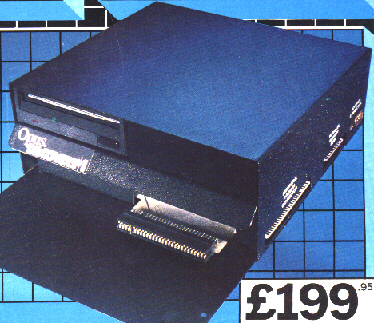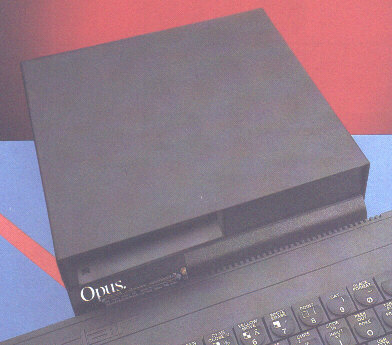Opus Discovery

The following advert was taken from
Your Spectrum Issue18
THE NEW DISC DRIVE SENSATION
At last Spectrum owners can
choose a TRUE disc drive system for their computer, backed by REAL software support and
available with the most comprehensive specification yet developed.
For just £199.95 Discovery offers a new level of performance and a combination of
advanced features which make other fast storage systems for the Spectrum and Spectrum +
look obsolete.
No wonder one leading computer magazine, Sinclair User, recommended Discovery in its
latest guide to fast storage systems for the Spectrum.
Discovery has been designed
to take no USER RAM from the Spectrum during the use of tape
based programs, it accepts the same commands as 'Interface 1' allowing you to use many of
the
cassette programs designed for microdrive and we've provided you with the firmware to use
a
super-fast RAM DISC when you choose. Random access files are fully supported and
formatting
and back-up routines are included in ROM.
Add to all this a range of
great software titles on the latest 3.5inch disc cartrisges commissioned
by Boots and you begin to see why we named it Discovery.
Specifications:
250k 3.5inch disc dirve.
Video monitor output.
Joystick interface.
Peripheral through connector.
Parallel printer port.

The following review was taken from Advanced Home Computer
Sinclair Research has provided the
Microdrive for the Spectrum, but a need has remained for a more reliable and accommodating
disk drive system. We conclude our two part series on alternatives to the Sinclair
Microdrive by examining the Discovery 1 from Opus, following our look at Rotronics'
Wafadrive.
In the previous Hardware article we looked
at the Rotronics wafadrive. Although this device proved to be
somewhat more reliable than the Microdrive, it turned out to be slower in comparison, and
still based around
the rather suspect continuous tape system. In this article we turn our attention to a more
conventional approach
to mass storage: a disk-based system from Opus Supplies.
A disk drive for the Spectrum does not
represent a new idea. Over the past couple of years there have been a
number of disk operating systems and interfaces available for the machine; however, none
of these systems have become particularly popular. This is partly because the interfaces
have been advertised solely in the specialist press, which has given the devices an air of
being intended only for the devout Spectrum enthusiast and machine code programmers, and
partly because they have been available only through mail order houses and have not been
given the kind of mass marketing needed to push them into the public consciousness.
The Discovery 1 is encased in sheet metal,
extending the front of the machine to support the Spectrum that plugs into a cartridge
slot via the expansion port. Although this seems a comparatively easy operation, users may
find some difficulty in attaching the Discovery to the edge connector. This is because the
cassette and aerial leads tend to get in the way and prevent the cartridge slot from being
attached correctly. Bearing in mind that a badly attached edge connector could severely
damage the Spectrum, this is a serious problem. The difficulty is not as pronounced with
the original Spectrum (for which the Discovery was originally designed), but the new
Spectrum +, with its larger casing, may have users struggling for several minutes before
they are satisfied that the device is correctly fined. Once the Spectrum has been fitted
to Discovery 1, the machine effectively blocks off the computers own power supply input.
The Discovery has therefore been designed to power both itself and the Spectrum, thus
making the micro's own external power supply redundant.
DUAL DRIVE UPGRADE
Above the cartridge slot on the left is a
single 3.5inch disk drive, with space on the right for a second drive. (Opus intends to
launch a dual drive version of the machine called the Discovery 2.) Discovery 1 users
wishing to upgrade their systems to dual drive configurations can expect an external
additional disk drive called Discovery + to be launched. However, users will not be
limited only to Opus drives since the company claims that standard 5.25inch disk drives
can also be added in the same manner.
In common with Rotronics, Opus's philosophy
in designing the machine is to provide not only a mass storage
system for the Spectrum, but also to add extra peripheral interfaces allowing users to run
printers and other devices.
A composite video monitor socket on the back of Discovery I has been provided, according
to an Opus
spokesman, for business users wishing to attach a monochrome monitor (although of course
composite video
does produce a colour signal) for lengthy periods of word processing. However, on a
machine noted for its
colourful games programs, it is a pity that Opus could not have provided an RGB interface
to produce a much
clearer picture.
On the right side of the Discovery is a
single Kempston-compatible, Atari-standard joystick port, next to which is a
bi-directional Centronics parallel printer port. Finally, there is a peripheral through
connector to enable other
Spectrum-compatible interfaces, such as an RGB monitor, to be connected.
Like the Wafadrive, the Discovery disk
operating system closely follows that of the Interface 1; for example,
issuing a command requires <GOMMAND> *. When the BASIC interpreter reaches the *, it
does not recognise
it as being a BASIC command and attempts to generate a syntax error. However, the DOS
intercepts it and
pages its own eight Kbyte operating system into the position of the lower eight Kbytes of
the Spectrum's ROM,
and then interprets the command. It should be noted that if the user has made a syntax
error, even the DOS
won't recognise it and an error message will be generated, although this will still be via
the DOS ROM.
In designing its DOS system, Opus has gone
further than Rotronics in providing Compatibility - all of the
commands available to the Microdrive have been retained. There are several reasons for
this. Because of the
Spectrum's single keyword entry system, it is obviously easier to write an operating
system using inherent
commands, rather than going to the trouble of writing your own. This also means that users
who are already
familiar with the Microdrive operating system will be able to use the Discovery
immediately, since all the
syntax is the same. Furthermore, tinkering with an operating system can lead to all kinds
of unforeseen
problems with the memory map. This means that programs compatible with Interface 1 may not
necessarily
be compatible with your revamped operating system, a problem that has plagued many other
third party
peripherals.
The way in which Opus has closely followed
the Sinclair Microdrive command system is most noticeable when
looking at the way the streams have been organised. On the Spectrum, output channels are
organised into 16
streams numbered 0 to 15. Three of these are set aside for the screen, keyboard and
printer, the others are free for use by any other peripheral. In the Sinclair list of
Interface 1 commands, there are a number of single
characters that open channels to specific devices; for example 'm' for Microdrive. The
Discovery has adapted these to its own use, thus the command LOAD * ‘m';1;'name’
will work just as well on Discovery 1 as on a
Microdrive, although in this case 'm’ refers to the disk drive. However, for added
convenience, Opus has adapted the command format so that ‘m' can be omitted, thereby
shortening the somewhat long-winded Sinclair system.
Other commands have also been adapted. The character 't' in a command on the Microdrive
opens a channel to
the RS232 interface, whereas on the Discovery it opens the channel to the parallel
printer.
THE DISKS IN OPERATION
The disk drive supplied with the
system uses the double-density Sony format 3.5inch disks that are becoming
increasingly popular on microcomputers. The disks themselves each have a total capacity of
250 Kbytes, which, when formatted, provide 180 Kbytes of available storage space. The disk
operating system supports random access when searching for a file, which is considerably
faster than the serial search methods used on some other disk systems. Also, there is no
limit to the number of files that can be held on a disk, which can be important then one
wishes to save a number of short files. If the directory is quickly filled, there may be a
large amount of space on the disk that cannot be used.
When comparing the time it takes to SAVE
and LOAD a file using the Discovery and Microdrive the former proved to be somewhat faster
in actually finding a file but considerably slower in SAVEing and LOADing it. Finding a
file is faster on the disk system because the files are organised by random access whereas
the Microdrives, by their nature, are serial access devices. Why accessing a file into
memory is much slower is more difficult to explain, but it is a fact that the transfer
rate of the Discovery 1 is much slower than that of the Microdrives - 15 Kbaud compared to
19.2 Kbaud. The real advantage of the Discovery lies in having a mass storage system more
robust than the Microdrive's, and a storage medium having a wider range of manufacturers
to choose from.
Opus appears to have given some thought to
the problematic aspect of software support for the Discovery.
Obviously having a large company like Boots selling the product in their chain of stores
is an advantage, since
software houses will be able to offer their products alongside the machine itself. The
company has also
indicated that many software houses, including Melbourne House and Legend, have already
agreed to transfer
some of their existing programs onto the 3.5inch disks.
The launch of the Discovery series of disk
drives has clearly been well planned and Opus has obviously
attempted to provide its new line with as much chance of success as it possibly could. For
the company,
the major task before it is convincing Spectrum owners that the Discovery is a more
worthwhile investment
for their machine than the Sinclair alternative. If the time is right and the Spectrum
owner is ready for a
disk-based system, Opus and its Discovery 1 could well be a success. |

